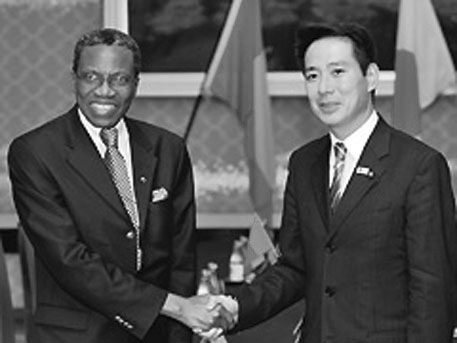Japan's Official Development Assistance White Paper 2010
Chapter 3 Initiatives through the TICAD Process
Japan actively supports African countries, which hold the key to the achievement of the MDGs.
Japan actively promotes cooperation for Africa’s own development programs based on the Tokyo International Conference on African Development (TICAD) process, guided by the principles of African ownership and international partnership.
At the Fourth TICAD (TICAD IV) held in Yokohama in May 2008, lively discussions took place on the vision for Africa’s development under the basic theme of “Towards a vibrant Africa: A continent of hope and opportunity”. The discussions were intended to support the positive changes observed in Africa in recent years and mobilize the knowledge and resources of the international community. The conference focused on three priorities: “boosting economic growth”, including trade and investment promotion through the development of infrastructure and investment environment; “ensuring human security”, including “achievement of the MDGs” and “consolidation of peace and good governance”; and “addressing environmental issues/climate change”. As part of its assistance measures for Africa, Japan pledged to double ODA to Africa by 2012 (Note 7), support the doubling of Japanese private investment, and provide ODA loans of up to US$4 billion over five years. In addition, Japan announced a variety of assistance measures for the sectors of the Yokohama Action Plan, which was unveiled at the conference.
1. TICAD Follow-up Meetings
At the First TICAD Ministerial Follow-up Meeting held in the southern African country of Botswana in March 2009 amidst the worldwide financial and economic crises, Japan announced a crisis response package (Note 8), which was based on a firm resolve to not allow the financial and economic crises to set back African growth and the achievement of the MDGs. At the Second Ministerial Follow-up Meeting (Note 9) held in Tanzania in May 2010, Japan confirmed that it had faithfully executed the package and was commended for making progress on the commitments made at TICAD IV. Specifically, the amount of Japan’s ODA to Africa between 2008 and 2009 has averaged US$1.7 billion annually, nearly reaching the pledged US$1.8 billion target. The provision of 45% of Japan’s pledged US$4.0 billion ODA loan target has also been committed as of the end of March 2010. While the majority of assistance in every area of the Yokohama Action Plan are being steadily implemented on the one hand, on the other, it was noted that the challenge ahead will be to further promote Japan–Africa trade, investment, and tourism, which suffered the impact of the 2009 financial and economic crises. For its part, Japan announced that it intends to make use of ODA loans and execute infrastructure projects up to US$2 billion over the next two years (Note 10), that it will provide assistance of approximately US$1 billion beginning from 2010 until the next Follow-up Meeting in fields related to the MDGs such as maternal and child health, and that it will intensify its assistance to Africa on climate change initiatives and seek to strengthen its cooperative relationship with Africa towards the establishment of the next climate change framework. These commitments were welcomed by participating countries.
At the Meeting, a Communiqué (official statement) was adopted as an outcome document of the Meeting to convey Africa’s perspective to important international fora, including the G8 Summit, G20 Summit, and the UN MDG Summit. The Communiqué commended the Government of Japan for its efforts on TICAD, as well as reaffirmed the need for stepped up assistance by the international community for the achievement of the MDGs, underlined the importance of African countries to demonstrate political will in their efforts to achieve the MDGs, and recognized that the TICAD Follow-up Mechanism (Note 11) was functioning effectively and that it presented a model for enhancing accountability and transparency regarding the implementation of commitments made by development partners and African countries.

Minister for Foreign Affairs Seiji Maehara holding talks with Foreign Minister Ehouzou of Benin
Notes:
(7) Double Japan’s ODA to Africa by 2012 from US$900 million to US$1.8 billion (excluding debt relief; includes contributions to the African Development Bank, etc.). US$900 million represents Japan’s average disbursements over five years (2003 – 2007) until TICAD IV.
(8) The package includes grant aid and technical cooperation of approximately US$2 billion for the coming years which will be implemented as swiftly as possible, US$300 million worth of food and humanitarian assistance, and the contribution of approximately US$200 million to the Global Fund to Fight AIDS, Tuberculosis and Malaria.
(9) Approximately 430 people in total participated, including representatives from 65 countries (31 of the participants were ministers from 42 African countries), 45 regional and international organizations, 12 NGOs, and the private sector. From Japan, Minister for Foreign Affairs Okada attended and acted as co-chair with Minister for Finance and Economic Affairs Mkulo of Tanzania.
(10) On May 4, 2010, the Government of Japan announced that in light of the commitments made at TICAD IV, Japan will provide ODA loans to middle-income countries in additional areas until the end of FY2012. Coupled with the traditional four areas of assistance for middle-income countries (“environment”, “human resources development assistance”, “disaster prevention/disaster relief”, and “reduction of disparities”), ODA loans will be provided for such projects as regional infrastructure, agriculture, and rural development projects, which contribute to poverty reduction through the promotion of economic growth in Africa.
(11) A mechanism launched at TICAD IV to verify the implementation status of the TICAD process. In principle, the TICAD Follow-up Meeting is convened once a year under the mechanism.
